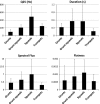Structural Classification of Wild Boar (Sus scrofa) Vocalizations
- PMID: 27065507
- PMCID: PMC4793927
- DOI: 10.1111/eth.12472
Structural Classification of Wild Boar (Sus scrofa) Vocalizations
Abstract
Determining whether a species' vocal communication system is graded or discrete requires definition of its vocal repertoire. In this context, research on domestic pig (Sus scrofa domesticus) vocalizations, for example, has led to significant advances in our understanding of communicative functions. Despite their close relation to domestic pigs, little is known about wild boar (Sus scrofa) vocalizations. The few existing studies, conducted in the 1970s, relied on visual inspections of spectrograms to quantify acoustic parameters and lacked statistical analysis. Here, we use objective signal processing techniques and advanced statistical approaches to classify 616 calls recorded from semi-free ranging animals. Based on four spectral and temporal acoustic parameters-quartile Q25, duration, spectral flux, and spectral flatness-extracted from a multivariate analysis, we refine and extend the conclusions drawn from previous work and present a statistically validated classification of the wild boar vocal repertoire into four call types: grunts, grunt-squeals, squeals, and trumpets. While the majority of calls could be sorted into these categories using objective criteria, we also found evidence supporting a graded interpretation of some wild boar vocalizations as acoustically continuous, with the extremes representing discrete call types. The use of objective criteria based on modern techniques and statistics in respect to acoustic continuity advances our understanding of vocal variation. Integrating our findings with recent studies on domestic pig vocal behavior and emotions, we emphasize the importance of grunt-squeals for acoustic approaches to animal welfare and underline the need of further research investigating the role of domestication on animal vocal communication.
Keywords: acoustic communication; graded vocalizations; sus scrofa; vocal repertoire; wild boar.
Figures



Similar articles
-
Honest signaling in domestic piglets (Sus scrofa domesticus): vocal allometry and the information content of grunt calls.J Exp Biol. 2016 Jun 15;219(Pt 12):1913-21. doi: 10.1242/jeb.138255. Epub 2016 Apr 8. J Exp Biol. 2016. PMID: 27059064 Free PMC article.
-
Encoding of situations in the vocal repertoire of piglets (Sus scrofa): a comparison of discrete and graded classifications.PLoS One. 2013 Aug 13;8(8):e71841. doi: 10.1371/journal.pone.0071841. eCollection 2013. PLoS One. 2013. PMID: 23967251 Free PMC article.
-
Vocal correlates of emotional reactivity within and across contexts in domestic pigs (Sus scrofa).Physiol Behav. 2017 Nov 1;181:117-126. doi: 10.1016/j.physbeh.2017.09.010. Epub 2017 Sep 11. Physiol Behav. 2017. PMID: 28912089
-
Forage Consumption and Its Effects on the Performance of Growing Swine-Discussed in Relation to European Wild Boar (Sus scrofa L.) in Semi-Extensive Systems: A Review.Animals (Basel). 2019 Jul 18;9(7):457. doi: 10.3390/ani9070457. Animals (Basel). 2019. PMID: 31323890 Free PMC article. Review.
-
Wild boar and infectious diseases: evaluation of the current risk to human and domestic animal health in Switzerland: A review.Schweiz Arch Tierheilkd. 2018 Jul;160(7-8):443-460. doi: 10.17236/sat00168. Schweiz Arch Tierheilkd. 2018. PMID: 29989552 Review. English.
Cited by
-
Social calls of the little auk (Alle alle) reflect body size and possibly partnership, but not sex.R Soc Open Sci. 2023 Sep 20;10(9):230845. doi: 10.1098/rsos.230845. eCollection 2023 Sep. R Soc Open Sci. 2023. PMID: 37736531 Free PMC article.
-
How do you do the things that you do? Ethological approach to the description of robot behaviour.Biol Futur. 2023 Sep;74(3):253-279. doi: 10.1007/s42977-023-00178-z. Epub 2023 Oct 9. Biol Futur. 2023. PMID: 37812380 Review.
-
Honest signaling in domestic piglets (Sus scrofa domesticus): vocal allometry and the information content of grunt calls.J Exp Biol. 2016 Jun 15;219(Pt 12):1913-21. doi: 10.1242/jeb.138255. Epub 2016 Apr 8. J Exp Biol. 2016. PMID: 27059064 Free PMC article.
-
Bison mother-offspring acoustic communication.J Mammal. 2024 Aug 8;105(5):1182-1189. doi: 10.1093/jmammal/gyae076. eCollection 2024 Oct. J Mammal. 2024. PMID: 39345853 Free PMC article.
-
Observation of rescue behaviour in wild boar (Sus scrofa).Sci Rep. 2021 Aug 10;11(1):16217. doi: 10.1038/s41598-021-95682-4. Sci Rep. 2021. PMID: 34376774 Free PMC article.
References
-
- Algers, B. 1993: Nursing in pigs: communicating needs and distributing resources. J. Anim. Sci. 71, 2826—2831. - PubMed
-
- Arnold, K. & Zuberbühler, K. 2008: Meaningful call combinations in a non‐human primate. Curr. Biol. 18, R202—R203. - PubMed
-
- Baotic, A. , Stoeger, A. S. , Li, D. , Tang, C. & Charlton, B. D. 2014: The vocal repertoire of infant giant pandas (Ailuropoda melanoleuca). Bioacoustics 23, 15—28.
-
- Boersma, P. & Weenink, D. 2014: Praat: doing phonetics by computer [Computer program]. Version 5.3.12 edn, University of Amsterdam, The Netherlands, Retrieved from http://www.praat.org/.
-
- Boisseau, O. 2005: Quantifying the acoustic repertoire of a population: the vocalizations of free‐ranging bottlenose dolphins in Fiordland, New Zealand. J. Acoust. Soc. Am. 117, 2318. - PubMed
LinkOut - more resources
Full Text Sources
Other Literature Sources
Miscellaneous
